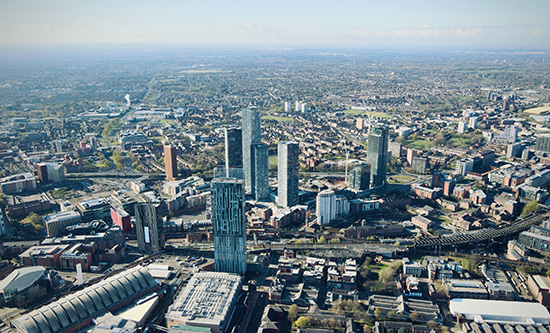
Since the global financial crisis of 2007-08 a new form of housing provision has been growing, as Build to Rent (BtR) lures investors with the promise of the huge and secure profits to be made out of the housing crisis in Britain.
BtR is the purpose-building on a mass scale of generally high-quality, high-rent flats owned and managed by large corporations or their agents rather than smaller private landlords. This kind of private rented provision has grown significantly over the past ten years: by the end of 2022, it accounted for over 240,000 units built or under construction in the UK. Property group Savills predicts that this will increase fivefold over the next decade as, with home ownership completely out of reach for most of the working class, increasing numbers of even better-off workers are being forced into the private rented sector. The typical tenant in the BtR market is the young managerial professional with a family, earning above £40k pa, who cannot afford a mortgage but can, for the moment, afford to rent something decent. The newly-built homes are made attractive by low-risk, secure three-year tenancies, efficient maintenance, fast internet and other amenities.
The UK has been slower than Europe and the US to capitalise on this development. In 2010 in the Netherlands and Switzerland nearly half of property investment was in BtR but only 1% in the UK. Beginning in London it has crept north to Birmingham, Liverpool, Leeds and to a greater extent, Manchester.
In Manchester city centre, Salford Quays, central Salford and the Pomona area of Trafford, out of 45,000 housing units built between 2012 and 2020, 22,984 were BtR, nearly one fifth of the national total. Of these 45,000, only 471 were classed as ‘affordable’ when policy guidance is 20%. The UK government, at both national and local level, has helped the BtR market to take off. A £1bn BtR fund was made available to underwrite the investors’ projects between 2012 and 2016, and planning permission was relaxed. The Greater Manchester Housing Investment Fund (GMHIF) lent out £167m to six high-profile developers and cut back on social housing. In the eight years 2012-2020 only £15.4m went into social housing while £8.3bn flowed into BtR.
In London former council land, close to schools, transport links and other amenities, has been largely sold off, scattering the working class far and wide away from their support networks to be replaced by the ‘rent generation’. In Manchester, however, although there has been some of this seizure (and will be more as building spreads eastwards), developers have taken advantage of cheap brownfield land, a flat topography and a city centre of warehouses and mills hollowed out by de-industrialisation from the early 1990s. The Conservative governments of the 1970s and 1980s cut local government funding and allowed local authorities to address industrial decline on their own terms. Ideologically, leaders in Manchester city’s ruling Labour Party pursued a form of ‘municipal entrepreneurialism’ and prioritised inward investment into property assets. In 2014 the Greater Manchester Combined Authority, made up of ten Greater Manchester local authorities (such as Bury, Salford, Rochdale and Stockport) overseen by a directly elected mayor, created the GMHIF with a £300m government loan. In 2014 Manchester City Council and the Abu Dhabi United Group (ADUG) which owns Manchester City Football Club, agreed to develop private apartment housing in the Ancoats district, 74.8% of it BtR. Senior councillors and officers sit on the board and all rents and sales revenues go offshore through Loom Holdings, owned by ADUG and registered in Jersey, obscured from public scrutiny.
Rental housing has become a major anchor for global finance over the past two decades. There is a deep reservoir of capital ready to finance the development of BtR property assets within the Greater Manchester city regional centre. 66.7% of BTR units in Greater Manchester are financed from overseas including the US, Canada, the Middle East, China and Europe with much of the profits registered in tax havens like the Cayman Islands. High profits are expected when interest rates are low and there are significant economies of scale in running multiple blocks of flats in the same area. National and local authorities have tried to create the most beneficial climate for BtR investors and clearly see it as an answer to the housing shortage. But it is vulnerable to crisis. It is a quality investment entirely dependent on rising house prices and rising rents. This apparently inexhaustible source of revenue for corporate investors is a desperate speculation masquerading as prosperity. Since 2021 the Bank of England has increased the base rate of interest from 0.25 to 4.25% in response to inflation, squeezing both tenants and landlords.
The BtR boom in Manchester now appears to be stalling. Of the total projects granted planning permission only 23.4% have been built, 43.5% are under construction and 33.1% have yet to start. Things move at a snail’s pace. Even to the casual observer Manchester city centre is a grotesque building site. At their conference last September Manchester’s Labour MP Lucy Powell said, ‘Labour will force developers to build more truly affordable homes that cannot be sold off to second-home owners and foreign investors’. How? ‘The Conversation’ organisation from Sheffield University, whose lead author Adam Leaver is a member of the Labour Party, calls for ‘an urban development model built on a new compact between national and local state organs to build good quality social and affordable housing where benefits would be recycled locally, rather than drifting off into tax havens.’
A genuine socialist opposition would see this huge concentration of international capital in real estate as an opportunity for expropriation and the reclamation by the working class of the wealth that has been stolen from it.
Pete Lynch
FIGHT RACISM! FIGHT IMPERIALISM! 293 April/May 2023




